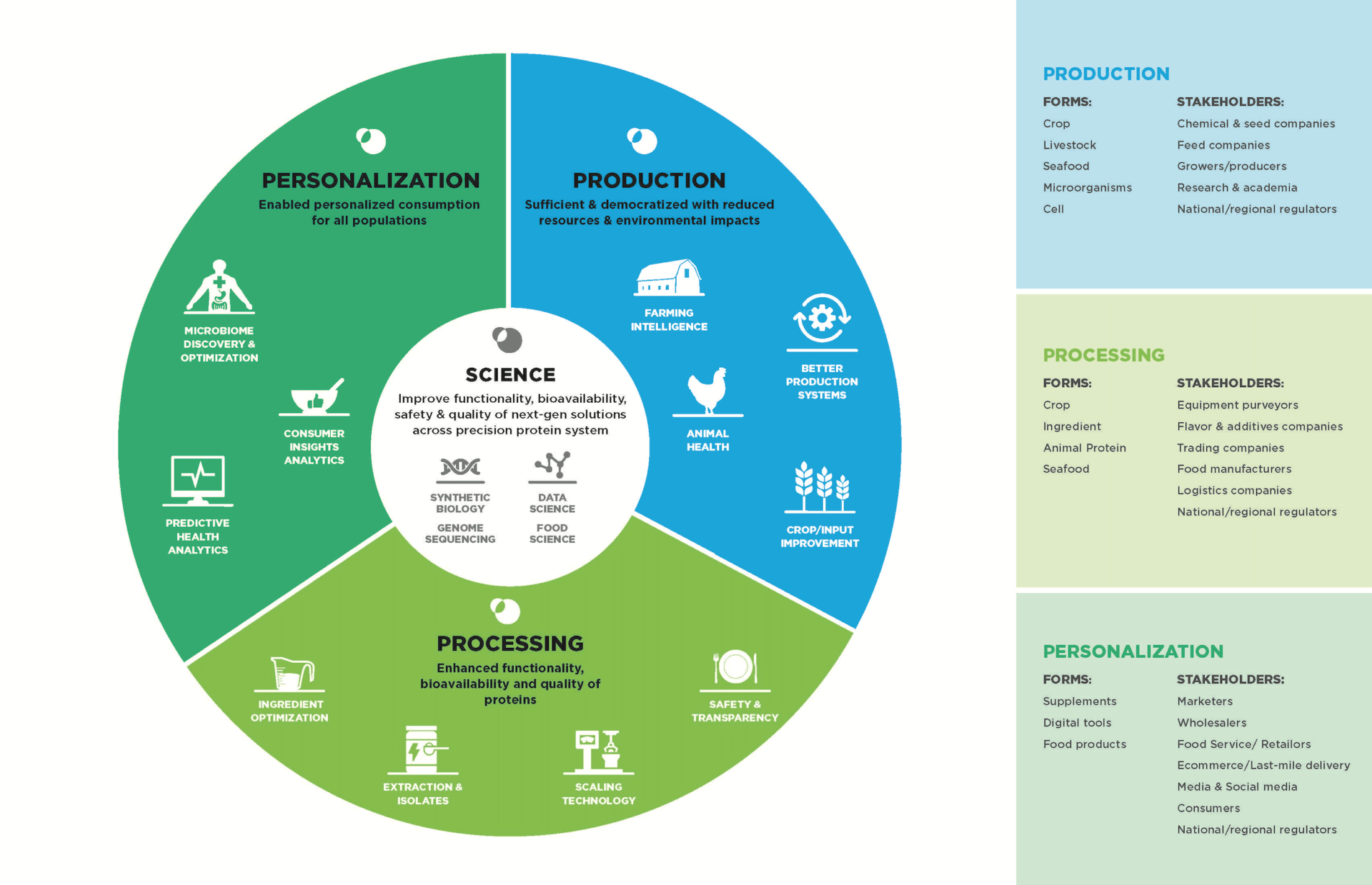Editor’s Note: An Wang, Rajiv Singh, Victor Friedberg, and Sara Eckhouse share with AFN FoodShot Global‘s new Precision Protein framework as part of the launch of its second FoodShot, which centers around protein this year. FoodShot Global is an AgFunder Network Partner.
Last month, FoodShot Global launched our second FoodShot as part of a long-term commitment to nutrition. Within that commitment to nutrition, we focused on protein, a macronutrient that is essential to human and animal nutrition and that has an outsized environmental footprint in our current system. As part of our effort to collectively work towards a healthier, more sustainable, and more equitable food system, we put forward a new framework that looks at protein systemically and with heightened rigor in order to build a protein system that is more precisely attuned to human and planetary health, better aligns global and regional supply and demand, increases accessibility, and decreases waste and environmental damage. We call this new framework “Precision Protein.” Now, as we introduce the Precision Protein framework, we believe it is important to illustrate the idea and ecosystem at the core of this concept.
So why do we need Precision Protein? The recent Global Nutrition Report 2020 found that one in nine people is hungry, while one in three is overweight or obese. An increasing number of countries have the “double burden” of malnutrition, obesity, and other diet-related diseases such as diabetes, cardiovascular disease, and cancer. Last month the UN warned that the coronavirus pandemic could double the number of people facing acute hunger globally. Critically, the report cites inequities in food and health systems as exacerbating inequalities in nutrition outcomes, which in turn can lead to more inequity, perpetuating a vicious cycle. At the same time, environmental damage from agriculture – specifically the conversion of natural ecosystems to croplands and pastures to meet the growing global appetite for protein – is a major risk factor for increased contact between humans and animals, which in turn increases the likelihood of zoonotic diseases like Covid-19.
With the world facing challenges from population growth, unsustainable consumption patterns, climate change, and pandemics, it’s clear that the democratization of nutrition is the next frontier of food. Our nutritional future will require advances in sourcing, processing, and delivery of macro-nutrients (protein, fiber, fat, and carbohydrates), micro-nutrients (vitamins and minerals), and phytonutrients (plant-based compounds with antioxidant and anti-inflammatory properties).
But what, precisely, does Precision Protein mean when it comes to our food system? What types of innovations will enable Precision Protein to succeed? What are the goals of Precision Protein, and how will we achieve them? Every protein sector, every stakeholder, and every step in the supply chain has a role to play in Precision Protein by leveraging advances in science and innovation to fully realize the power of protein for better human and planetary health.
Precision Protein Innovation Map

SCIENCE is at the center of Precision Protein because scientific progress drives advances across human nutrition and the food supply chain. We must support innovative science to achieve a deeper and more precise understanding of the role of proteins in human health and development, including the functional aspects of amino acids and peptides. By investing in key innovations – including synthetic & molecular biology, genome sequencing & editing, bioinformatics, data and food science, and machine learning – we can achieve one of our key goals: Improving the functionality, bioavailability & quality of next-gen solutions across the Precision Protein system and the supply chain.
Moving out from science, we turn to the role of Precision Protein in the main steps of our food and agriculture supply chain: production, processing, and personalization (consumption).
In the context of PRODUCTION, our food system is under growing pressure to produce food for a growing global population and a rising global middle class. There will be a critical role for all protein-producing sectors, including livestock, fisheries, aquaculture, plants, and emerging sectors like algae, mycoprotein, cellular agriculture, insects, and more. This will require innovations in farming intelligence, crop & input improvement, animal health (disease prevention, feed improvement, etc.), and improved/new production systems.
Ultimately, we want to achieve efficiency and precision in protein production, while ensuring not only protein quality (essential amino acids), but also material reductions of inputs (water, energy, chemicals, seeds & feed) and the drastic reduction of negative environmental impacts. Successful innovations will improve protein production and enable new types of crops, livestock, micro-organisms (yeast, bacteria, and fungi), and cells, thereby securing sufficient and democratized proteins from all sectors to meet global needs.
We expect these innovations to target both availability of protein as food and feed at scale, as well as to unlock the availability of other essential nutrients and therapeutic compounds through protein molecules functioning as enzymes, peptides, growth factors, hormones, immunoglobins and antibodies.
PROCESSING is a critical next step in the Precision Protein System. Once precision proteins have been produced to maximize quality and yield while meaningfully reducing resource requirements and environmental impacts, there is a need to protect their integrity and longevity for use as food ingredients. We need to protect the integrity of proteins and peptides, reduce supply chain costs (sourcing, production, processing, storage, and distribution), reduce waste, and maximize resource use efficiency. To enable the Precision Protein future, we need processing innovations in areas like ingredient optimization, extraction & isolate creation, food safety & transparency, scaling of precision fermentation and bioreactor optimization, and closed-loop/other novel business models that facilitate resilient regional food chains.
With these innovations, Precision Protein Processing will improve and create new forms of crops, ingredients, processing technologies, and storage/distribution models in order to ultimately enhance the functionality, bioavailability and quality of proteins in our food.
Finally, we turn to PERSONALIZATION in a Precision Protein System. We know that nutritional needs change depending on age, activity level, lifestyle, and individual health conditions. As the world faces an alarming rise in diet-related death and disease, there is a clear need for nutrition to become more regionalized and personalized. In a Precision Protein future, with a better scientific understanding of protein efficacy allowing for better functionality, bioavailability and quality of proteins; and with precision protein production yielding high quality, sustainable and accessible supplies; protein consumption must be personalized and linked to individual nutrition needs. Achieving Precision Protein Personalization will require innovations in areas like generating better consumer insights, microbiome discovery, analytics and optimization, and predictive health.
With robust consumer data and insights, personalized digital tools, and next-generation supplements, and foods, Precision Protein will enable protein consumption to be personalized and linked to individual nutrition needs in a way that supports FoodShot’s mission of a more equitable food system.
You may still be wondering how you or your organization fits into the Precision Protein System. Just like FoodShot Global as an organization is based on the power of collaboration, the Precision Protein framework requires collaboration and coordination across stakeholders. Chemical and seed companies, farmers, regulators, distributors, manufacturers, researchers, consumers, investors, and entrepreneurs of all types have a role to play.
By working together to build a Precision Protein System, we’ll be able to leverage science, technology, investment, and innovation to deliver the maximum benefits to human and planetary health while minimizing resource inputs.
*This article was sponsored by FoodShot Global.*




